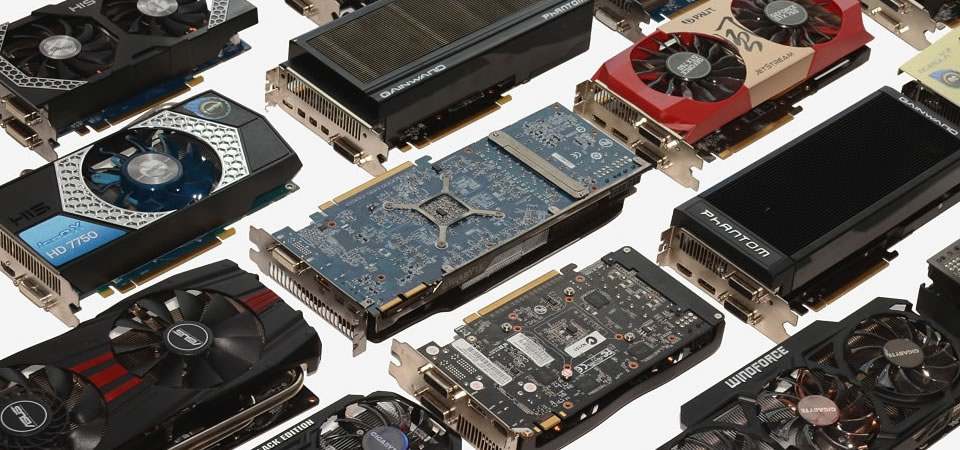It's been an eventful year for GPU releases with updated models and prices across all budgets from both AMD and Nvidia. After finally shipping the Radeon R9 290X and R9 290 late in 2013, AMD returned to rebadging parts in February with the R7 250X (essentially an HD 7770), followed by an overclocked HD 7850 (the R7 265) and then a clone of the two-year old HD 7950 (the R9 280).
We received something fresh with the R9 295X2 in April, but with pricing around $1,000 it was cheaper to buy two R9 290Xs for the same or better performance. Rounding out the year, AMD delivered its next-gen Tonga architecture in the R9 285, but the card was crippled by a 256-bit memory bus and struggled to outpace the similarly priced R9 280 while being slower than the 280X.
Meanwhile, Nvidia had already shown off its next-gen tech in February with the unassuming GeForce GTX 750 series. Built using the new Maxwell architecture, the GTX 750 demonstrated amazing performance per watt but was out-priced by the R7 265. However, it wouldn't be until seven months after the debut of the GTX 750 series that things would get truly interesting.
Mid-way through September Nvidia unleashed its Maxwell-powered GTX 900 series with the GTX 970 and GTX 980. Despite featuring 27% less transistors in a 29% smaller die using the same 28nm design process as Kepler, Nvidia was able to make Maxwell faster. The advantage of making Maxwell less complex meant that it consumed less power and so it was more efficient.
In the end, the GTX 980 was 20% faster than the R9 290X while costing slightly more and the GTX 970 was 3% faster than the R9 290X and 16% faster than the R9 290 while costing 12% less than the former. With Maxwell crushing Hawaii, AMD was forced to slash prices days after the GTX 980 and GTX 970 were revealed (a triple digit drop to $400 in the case of the the R9 290X).
| AMD and Nvidia graphics cards by price range | |||||
| $400 - $600 | GeForce GTX 980 | $580 | |||
| GeForce GTX 780 Ti | $450 | ||||
| $300 - $400 | Radeon R9 290X | $370 | GeForce GTX 970 | $370 | |
| $250 - $300 | Radeon R9 290 | $280 | |||
| GeForce GTX 770 | $270 | ||||
| Radeon R9 280X | $260 | ||||
| $200 - $250 | Radeon R9 285 | $250 | |||
| GeForce GTX 760 | $220 | ||||
| Radeon R9 280 | $200 | ||||
| $150 - $199 | Radeon R9 270X | $190 | |||
| Radeon R9 270 | $170 | ||||
| Radeon R7 265 | $150 | GeForce GTX 750 Ti | $150 | ||
| $100 - $149 | Radeon R7 260X | $120 | GeForce GTX 750 | $120 | |
Since then, pricing has continued to plummet with cards selling for under $350 with rebates, though the average price is about $370. It seems that AMD can't unveil its next-gen GPUs quickly enough, though we are told there won't be any more releases from either camp in 2014, with both holding off for the first quarter of 2015. Therefore a price war will be waged in the meantime.
While we're always looking forward to testing the latest hardware from each outfit, it's still great news for PC gamers if the companies plan to make the existing high-end graphics cards more affordable, especially for those of you who have a shiny new GPU at the top of their Christmas list. Let's break down each price bracket to determine which company offers the best value product.
Methodology
Although we collected the frame time data we didn't include it because it's becoming less important for single-GPU reviews. Our results showed the GeForce GTX 970 to be in line with the R9 290X for example, which is about what we would expect, so there isn't much to see here. Frame time data will still be included in our CrossFireX and SLI reviews.
For this review we've tested at 1920x1200 and 2560x1600, though we will only be discussing the 1920x1200 results as the lower end cards performed better here. We are yet to include 4K results or higher because there isn't a single-GPU solution available that can provide playable performance at this resolution.
Test System Specs
- Intel Core i7-4770K (3.50GHz)
- x2 4GB Crucial DDR3-2400 (CAS 11-13-13-28)
- Asrock Z97 Extreme6 (Intel Z97)
- OCZ ZX Series (1250W)
- Samsung SSD 850 Pro 512GB (SATA 6Gb/s)
- Gigabyte Radeon HD 290X (4096MB)
- Gigabyte Radeon HD 290 (4096MB)
- HIS Radeon HD 280X (3072MB)
- HISRadeon HD 285 (2048MB)
- HIS Radeon HD 280 (3072MB)
- HIS Radeon HD 270X (2048MB)
- HIS Radeon HD 270 (2048MB)
- HIS Radeon HD 265 (2048MB)
- HIS Radeon HD 260X (2048MB)
- Gigabyte GeForce GTX 980 (4096MB)
- Gigabyte GeForce GTX 970 (4096MB)
- Gigabyte GeForce GTX 780 Ti (3072MB)
- Gainward GeForce GTX 780 (3072MB)
- Gainward GeForce GTX 770 (2048MB)
- Gainward GeForce GTX 760 (2048MB)
- Gigabyte GeForce GTX 750 Ti (2048MB)
- Gigabyte GeForce GTX 750 (2048MB)
- Microsoft Windows 8.1 Pro 64-bit
- Nvidia GeForce 344.07
- AMD Catalyst 14.7


